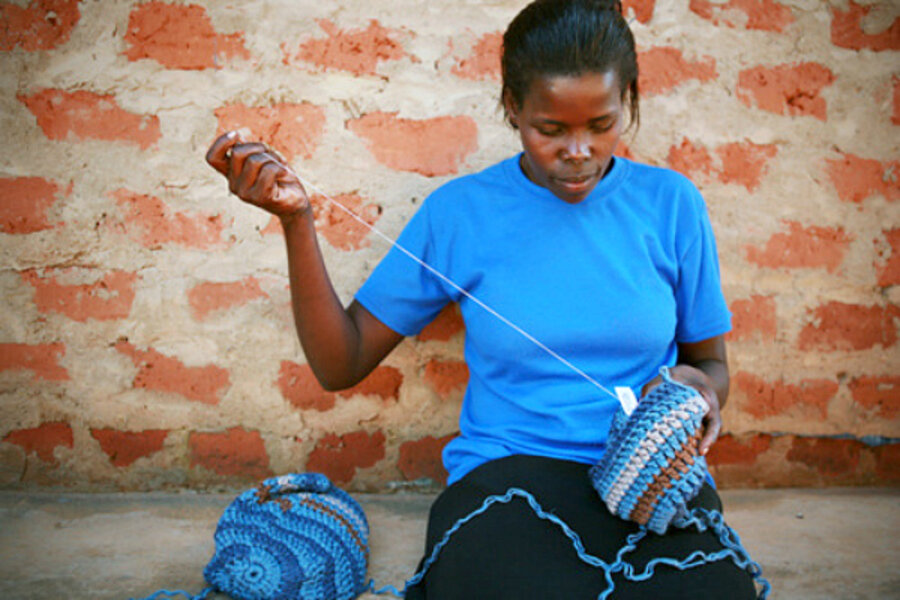Krochet Kids knits together sustainable jobs
In Uganda and Peru, a team of lifelong friends is turning a love of crocheting into jobs for impoverished women.
Krochet Kids International trains and employs women in both countries to craft contemporary apparel for sale in the United States. Global Envision recently talked with Adam Thomson, the nonprofit’s vice president of impact.
Krochet Kids’ model creates sustainable jobs by teaching textile skills like crochet or knitting, and attempts to help women permanently escape poverty through additional business training and mentoring. Part of what sets Krochet Kids apart, according to Thomson, is a rigorous “measurement and evaluation system” to quantify and better understand the impact of the organization’s work. The Krochet Kids team sees this analysis as so fundamental that they wanted Thomson’s title to reflect it.
“We’re really driven – obsessed really – with measuring impact,” he said.
The original Krochet Kids – cofounders Kohl Crecelius, Stewart Ramsey, and Travis Hartanov – discovered the lucrative potential of crocheting while looking for ways to finance their high school prom in Spokane, Wash. Their handmade, one-of-a-kind beanies were a hit with classmates, who purchased them as fast as they could churn them out. Even after tuxedo rentals and other expenses, the crew had $1,000 left over.
The idea to use crochet to kickstart a nonprofit came from a pivotal 2006 summer trip that Ramsey took to volunteer at a Ugandan refugee camp. He heard from many people there that while the government and nonprofit aid they received helped them survive, their strongest desire was to find work so they could provide for their families independently.
When Stewart returned, the three made a plan to register as a nonprofit and raise money to seed their vision for a new kind of aid organization, eventually settling on the name Krochet Kids. After recruiting help from friends and a round of successful fundraising, they returned to Uganda in 2007, armed with bags of yarn, needles, and high hopes for making change.
Starting a nonprofit in Africa as college students inevitably resulted in some growing pains. As the three cofounders told the New York Times Magazine, building relationships and determining who to train were difficult challenges. But four years later, revenue from sales has jumped from just under $50,000 in 2008 to $1.5 million in 2012. Between administrative staff and garment workers, Krochet Kids now employs 235 people.
Beyond reaching profitability, Krochet Kids wanted to tackle another overarching problem: How do you provide aid in such a way that eventually it will no longer be needed? Rather than just providing work, the team wanted to understand and address as many of the complex factors that trap people in poverty as possible.
Krochet Kids tracks each of their more than 200 workers on a monthly basis using more than 40 different metrics of "well-being." These include obvious indicators like income and savings, but also more indirect measurements like school attendance rates for the women’s children.
This holistic approach generates a vast amount of information to sift through and analyze. Some of the promising results? On average, women working for Krochet Kids earn 10 times their previous salary, have increased their savings by a factor of 25, and their children are also about 25* times more likely to attend high school.
Sometimes initiatives don’t have a measurable impact. Thomson cited an early effort to train women on HIV prevention that floundered until they brought in a trainer the women felt more comfortable with.
“We’ll see that our first try at something isn’t necessarily the best and requires that we retool and try a second or a third time,” Thomson said. “It’s a messy process. We’re working with people, and there is no silver bullet.”
Krochet Kids also ensures a viable market for their worker’s beanies, scarves, and other apparel by supplying product designs that are created by an in-house fashion designer and tested for the US market. Products are sold directly through the Krochet Kids website, but also at major US outlets like Urban Outfitters, Whole Foods, and Nordstrom.
“We found that the women we work with are more interested in making products they know will sell, as opposed to demonstrating a lot of individual expression,” he said. “The feedback we’ve gotten is: ‘Tell me what to make and how to make it.’ ”
Each Krochet Kids item is hand-signed by its maker, and each woman has a short profile on the company’s website, like Auma Joyce, from Uganda. Consumers can also personally connect with the woman who made their piece by writing them a thank you note via the website.
Looking ahead, Thomson sees Krochet Kids training more women and possibly expanding to other countries, but only by following the careful and deliberate path that’s led to its current success.
“We’re not trying to be a flash-in-the-pan organization,” he said. “We’d rather get our model right and have as much impact per person as we can.”
* A previous version stated children were 18 times more likely to attend high school. Krotchet Kids has since provided an updated statistic.
• This article originally appeared at Global Envision, a blog published by Mercy Corps.






